The Women of Salem’s Wartime Roundhouse
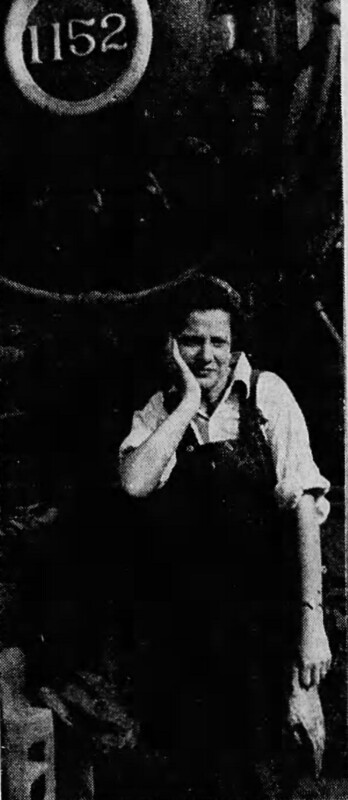
Donna Beall at the Salem Roundhouse. Photo by Ben Maxwell. Published in the Capital Journal Friday, May 24, 1946.
Ever since the arrival of Caboose 507 at the Willamette Heritage in 2017, we have been researching the history of the railroad in Salem. For the most part this history has centered around men. That was until a few weeks ago, when we found an article (and photographs) highlighting a group of women who were recruited during the labor shortages of World War II.
Women Join the Workforce
Women had worked for the Southern Pacific Railroad in a variety of areas, but usually in clerical work or as telegraph operators and station agents in remote areas.[1] World War II changed things dramatically. Over 13,000 regular Southern Pacific employees went to war,[2] but the lack of workers didn’t diminish the need for trains on the Homefront. In fact, wartime traffic and gas rationing increased the need for rail services.[3] The Southern Pacific went to extraordinary lengths to keep the trains rolling during this time. They recruited weekend workers from non-traditional occupations (history professors as one war time advertisement announced) and brought in work crews from Mexico. They also began recruiting women. As one Southern Pacific advertisement in a Salem paper stated: “We need patriotic women, too.”[4] The Southern Pacific would end up hiring over 3,000 women to help fill in the jobs traditionally held by men.[5] At least nine of those women worked in Salem. In the fall of 1942, the Southern Pacific hired four women to work in the Salem roundhouse and five to work on a local section crew.[6]
Salem’s Roundhouse
Now before you start envisioning a large semi-circular brick building and a turntable, the Salem roundhouse was never that — but rather the nickname given to a cluster of decidedly rectangular buildings located on the Salem-Geer Branch line “wye” near 14th and Oak Streets – about where the Willamette University softball field stands today.[7] The roundhouse had been established in Salem in 1926, the facilities consisting of a “converted box car” [8] and other shacks and sheds.[9] The roundhouse was responsible for the maintenance of locomotives[10] that ran out of Salem and employed a number of highly skilled machinists, pipefitters, boilermakers, welders, and electricians to make repairs and laborers and helpers to light fires in the locomotives and run the stationary boiler necessary for plant operations.[11] The Salem roundhouse employed between 11-30 men (and eventually women) until cost cutting moves closed it in 1958.[12]
Section Workers
Not far behind the roundhouse were a set of 8 railroad cars including an old Pullman passenger car that had been converted into a bunk house for section workers.[13] Section hands were responsible for track maintenance along different sections of track (hence the name).
Salem’s Women Recruits
“Women have made their appearance, in overalls and with oil cans, wrenches or shovels, as members of the work crews of the Southern Pacific Company in Salem. And – take it from C.P. Davis, roundhouse foreman – they are good railroaders,” the Capital Journal reported in December 1942.[14] While I’ve yet to find the names of the five women hired on as section hands in Salem, there are a number of newspaper articles detailing the four women hired on by the Salem roundhouse. They included a pair of sisters: Donna (Swank) Beall[15] and Helen “Lesley” (Swank) Lunn[16] and a pair of sisters-in-law Edna (Hirschkorn) Zander[17] and Leota (Real) Zander.[18] They would eventually be joined by Marguerite “Margie” (Buoy) Konrad.[19]
Davis was interviewed about his newest recruits and described them as very thorough and in perhaps the greatest compliment stated: “I wish I had started employing women 20 years ago.” He went on to describe their jobs: “What do they do? Well, for one thing they fire up the locomotives. Besides that, they fill the lubricators, fill the flange oilers and the sand boxes that sand the rails. Of course it takes a little time to teach the girls the tricks of the trade so they won’t get burned or otherwise injured.”[20] The women did the same job as men and received the same pay, except for that the Oregon State Bureau of Labor limited the hours they could work in a week, so it is likely the total take home pay was lower than their male counterparts in the end.[21] At the Salem roundhouse, there is documentation of women holding the positions of fire lighter, supply man and stationary fireman.[22]
Despite the limited hours, the work was still difficult and meant sacrifices within family life as well – most of the women employed were single mothers and several sent their children to live with grandparents during this time.[23]
Little Phoebe
Section hands and roundhouse workers weren’t the only women brought in during WWII. A narrow-gauge locomotive from Nevada, nicknamed “Little Phoebe” also made her debut at the Salem roundhouse during the war years.[24] Steam was necessary for roundhouse operations. It provided power for the workshop, heat for the buildings, hot water for cleaning the locomotives and warmed up the fuel oil so it could flow where it needed to go. Typically, the Southern Pacific would retire locomotives from their fleet to be used in in a stationary capacity to provide steam, but wartime shortages meant all the retirees were called out for active duty. Salem got lucky in finding this little engine – narrow gauge railroad was usually reserved for mining and logging railroads. The wheels were set too close together to use standard rail beds, so the Salem roundhouse build a special section of track just for “Little Phoebe.” Apparently much of the care of “Little Phoebe” was relegated to the women crew at the Salem roundhouse.[25]
End of an Era
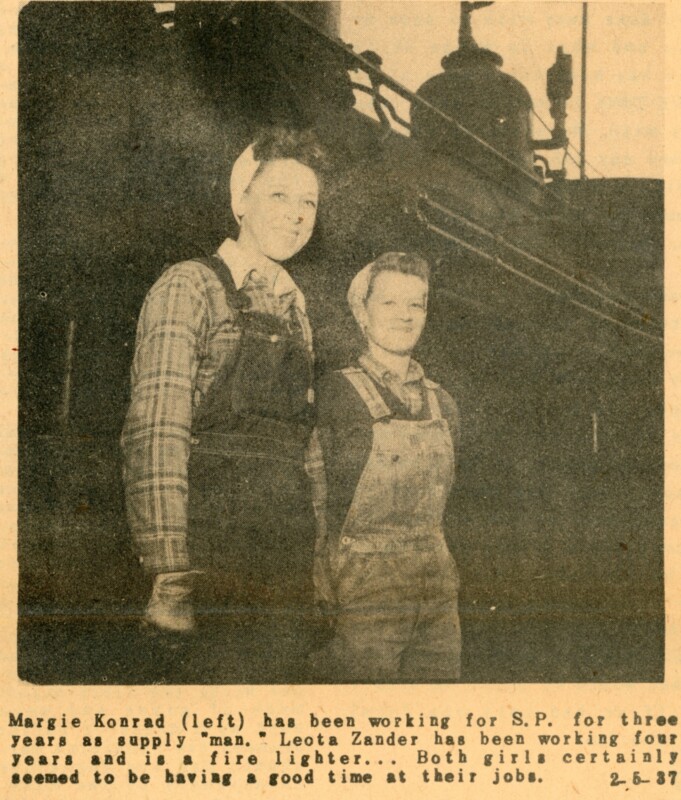
Margie Konrad and Leota Zander at the Salem Roundhouse. Published in Your Town Press. 31 Jan 1947. WHC Collections 0081.002.0063.001
Several of the women stayed on at the Salem roundhouse even after the end of the war, but not too long. By the 1949 city directory, none of the known women rail workers in Salem were still employed at the roundhouse. Some of this was due to changes in these women’s lives. A delightfully headlined article in March 1947 Oregon Statesman newspaper, “Fireman, Firelighter Get Marriage License” announced the engagement of H.A. Woodruff and Leota Zander.[26] The employment of others seemed to fall victim to the gradual restructuring of the railroad in the area. The switch from steam to diesel locomotives during this time meant a lessening of a need for firelighters.[27] Donna Beall was out of a job during a 1946 rail strike. While she didn’t strike herself, the striking railroad workers around her meant there was no work for her to do, leading her to look for other employment opportunities. [28]
“Little Phoebe” appears to be the last woman left standing at the Salem roundhouse, but even her days were numbered. She was cut up for scrap in 1952.[29]
The work these named and unnamed women did broke gender barriers, if only briefly. Even today, only 5.7 percent of rail workers in the United States are women.[30] It is surprising to me, how little their legacy is remembered, even by themselves. Of all the named women I was able to find obituaries for, only one made mention of working on the railroad.[31] I wonder how many more untold stories there are.
This article was written by Kylie Pine in 2023. It is reproduced here with citations and additional information for reference purposes.
Women of Salem’s Roundhouse Biographies
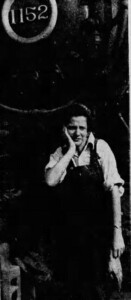
Donna Beall at the Salem Roundhouse. Photo by Ben Maxwell. Published in the Capital Journal Friday, May 24, 1946.
Donna Elizabeth Swank Beall Tuttle Wendling Luke (1912-1999)
Positions Held: Stationary Fireman
Donna Elizabeth Swank was born 17 Feb 1912, the fifth child of Monrico/Maurice Swank and Addlie Bailey in Canyonville, Douglas County, Oregon. She and her younger sister Helen Lesley both worked for the Southern Pacific in Salem.
Donna married Albert Edward Beall, a painter by trade, in 1929 in Roseburg, Oregon. They had a two sons and a daughter. By 1940, Donna and Beall had separated and both Donna and sister Lesley moved with their children back in with their parents in Glendale, Oregon. On December 28, 1940, Donna Married Lawrence Tuttle.
By 1942, Donna had moved to Salem and was working for the Thomas Kay Woolen Mill as a weaver. She and her sister would soon be hired on by the Southern Pacific as some of their first women workers in the roundhouse.
In addition to her war work for the railroad, she was also a faithful blood donor. On May 9, 1945, she reported her eight contribution, joining the “gallon club.”
Donna continued working for the railroad even after the war until the 1946 rail strike. By 1950 she had married Evan B. Wendling and moved to Portland where she worked as an attendant at a mental hospital. In 1957, she married Vern Ellsworth Luke.
Donna worked until retirement for the Asten-Hill Manufacturing Company in West Salem. She died On July 19, 1999 in Salem and is interred in Canyonville.
Sources and Transcriptions
Birth Certificate (Canyonville, Douglas, Oregon) (Ancestry.com)
Donna Elizabeth Swank, Female, fifth child. Born 17 Feb 1912 to Monrico Swank (43) and Addie Bailey (32)
1920 US Federal Census (Ancestry.com)
Glendale, Douglas, Oregon
Swank, Maurice, Head, 51, Blacksmith, Lumber co.
Addie M., Wife, 41
John, J. Son, 18, Laborer, Saw mills
Paul L, Son, 13
Margerite B., 10
Elizabeth D., Daughter, 7 9/12
Helen L, Daughter, 3 5/12
Marriage Record (Ancestry.com)
Douglas County
10 July 1929
Albert Edward Beall to Dona Elizabeth Swank
“Glendale” The News Review 13 Jul 1929 (Newspapers.com)
Glendale, July 13. Miss Donna Elizabeth Swank and Albert Beall, both of this city, were married at Roseburg Wednesday by Judge W.S. Hamilton. Mrs. Beall is the daughter of Mr. and Mrs. M.D. Swank, who have been residents of this city and Fernvale for many years. Beall is a recent newcomer to this city and is a painter by trade.
1930 US Federal Census (Ancestry.com)
Glendale, Douglas, Oregon
Bell, Albert, Head, 28, Caliofrnia, marriage age 27, Painter
Elizabeth, Wife, 18Oregon, married age 17, none
Elwin L, Son, 1/12, Oregon, none
Jackman, Albert, roomer, 31, Oregon, Carrier Driver, Saw Mill
Conasta, James H., roomer, 35, Texas, Faller, Loggin
Conatsen, Robert Leo, Roomer, 24, Oklahoma, Faller, Loggin
1940 US Federal Census (Ancestry.com)
Glendale, Douglas, Oregon
Swank, Maurice, Head, 70, Oregon, Blacksmith, Lumber Mill
Addie M., Wife, 61, Oregon
Beall, Donna, Daughter, 28, Oregon – Same house 1935, Sorter, Fruit Packing
E.Vern, Grandson, 10, Oregon – Same House 1935
Donna, Grand Daughter, 8, Oregon
Albert, Grandson, 5, California
Lunn, Helen, Daugher, 23, Oregon, Same ouse
Adeline, 2, granddaughter
Sandra, Grand Daughter, 2 /12
Marriage Records (Ancestry.com)
28 December 1940
___ Lawrence Tuttle
First Marriage Born Minnesota
To Donna E. Beall, Glendale, Oregon, White, age 28. Born Canyonville, Oregon. Second Marriage. Mother and Father born Oregon
Polk’s City Directory, 1942 (wHC Collections
Beall, Donna S., Mrs. , weaver, TKWMCo. H 1342 Lee
“Locals.” Capital Journal 04 Aug 1942, pg 15 (Newspapers.com)
Person finding Edmund Biggs billfold containing val. Papers and money return to Donna Beall, 1343 Waller St. Reward.
“Roundhouse Workers Include Gelndale Girls.” Roseburg News Review 28 Dec 1942 pg 4 (Historic Oregon Newspapers)
Two girls from Glendale, Ore. Are among the workers in the Southern Pacific roundhouse crew at Salem. Pictures of the four women employed by the S.P. at Salem were published recently in a Salem newspaper. Donna Beall and Lesly Lunn who were include din the photograph, are daughters of Mr. and Mrs. M.D. Swank, residents of Glendale, where the girls previously resided.
“Phoebe Narrow Gauge All Steamed up, Nowhere to go.” Capital Journal 22 Feb 1944 pg 10 (Newspapers.com)
PHOTO
Capiton: Phoebe Narrow Guage is Here Name. She is all steamed up with no place to go. Donna Beall, on of the S.P.’s seven women employes at Salem, appears in the cab.
“Full Quota of Blood Donors.” Capital Journal 09 May 1945 pg 7 (Newspapers.com)
Folk from near and far flocked to the blood donor center located on the first floor of the Frist Methodist Church Tuesday and as a consequence of 200-pint capacity of the mobile unit was filled without difficulty…Fourteen persons made their eighth contributions and received pins designating membership in the exclusive “gallon club.”..The eight-time donors were: Mrs. Donna Beall, S.P. Yards, James Richardson, S.P. yards;
1945 City Directory
Beall, Donna Mrs. Sta firemn SPCo h 1105 S 12th Street
“Strike Comes to Salem.” Capital Journal 24 May 1946 pg 1 (Newspapers.com)
PHOTO. When the 4 o’clock whistle blew Thursday afrternoon all switch engines operating in Salem were out of operation, above. Below left, Donna Beall, 1185 S.. 12th St. wonders what she’ll do next. She’s a stationary fireman, not on strike herself, but out of a job because others are…. (photos by Ben Maxwell, Capital Journal Photographer.
1947 City Directory
No Donna Beall – just Donna L Beal wife of Paul B. Beal asst prof WU h 165 Washington
“Medley Relay Champions.” News Review 05 July 1949 pg 10 (Historic Oregon Newspapers)
PHOTO
Caption: Donna Beall, Della Moore Schorn and Lavelle Flannery, Oregon 1948 women’s 300- medley champions will appear in Roseburg during the first Southern Oregon Invitational swimming meet to be conducted at the Municipal Pool July 9 and 10 unders sponsorship of the Roseburg Junior Chamber of Commerce. They are members of the Portland Aquatic Club.
1950 US FEDERAL Census (Ancestry.com)
Portland, Multnomah, Oregon
2605 lower SE 23rd Street
Wendling, Evan B., Head, 37, Oregon, Attendnants, Hospital for insane
Bess, D., wife, 37, Oregon, Attendant, Hospital for Insane
Beall, Vern, Stepson, 20, Oregon, Logger, Logging and Log Trucking CO
Donna B., step daughter, 18, Oregon, Telephone Operator, Telephone Co.
Albert L, stepson, 15, California
Marriage Certificate (Skamania Co.) (Ancestry.com)
24 June 1957
Vern E. Luke and Donna E. Wendling
Divorce Record Polk County (Ancestry.com)
Vern Ellsworth Luke and Donna Swank
Born Glendale, Oregon, 2/17/1912 age 55 White, Weaver Austin& Hill Manufacturing Co. Third Marriage. 215 Main Street, Dallas, Oregon
“Donna E. Luke.” Statesman Journal 22 Jul 1999 pg 21 (Newspapers.com)
Feb 17 1912 – July 19, 1999
Donna Luke, 87, of Salem died Monday of emphysema.
She was born in Canyonville and moved to Polk County 50 years ago. She was the first woman to work in the Southern Pacific Railroad yard during World War II. She was a weaver for Asten-Hill Manufacturing in West Salem until retiring. She enjoyed going to Reno and Spirit Mountain. She married Albert Beall in 1929, and they divorced. She married Vern Luke, and they were later divorced.
Survivors include her daughter Donna Cook of Salem; son, Vern Beall of Troutdale; six grandchildren; 19 great grandchildren and one great-great-grandchild.
At her requests no services will be held. Interment will be in Canyonville. Arrangements are by Crown Cremation in Milwaukie. Contributions: Willamette Valley Hospice or Humane Society.
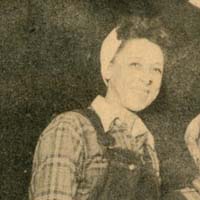
Margie Konrad, 1947. Your Town Press Article detail. WHC Collections 81.2.63.1
Marguerite “Margie” Grace Buoy Konrad Ainsworth Pierog (1909-1975)
Positions held: Supply Man; Stationary Fire Woman
Margie Konrad was born Marguerite Grace Buoy to George and Minnie () Buoy in Creswell, Lane County, Oregon on 6 November 1909. At age 19 she married John Walter Konrad, a 27-year-old farmer and WWI Veteran with five children. She and John would have two more sons, one of whom passed away as an infant from a meningitis infection.
Margie went to work for the Southern Pacific not long after the death of her husband in a motor vehicle accident in 1943. She worked as a supply man for at least 3 years in the Salem yard and is also listed as a Stationary Firewoman in the 1947 Salem City Directory. Sometime after 1947, it appears she may have married a man by the surname of Ainsworth. Eventually, she went into the nursing profession, working as a nurses aide at the Oregon State Tuberculosis Hospital. She married Andrew Pierog in 1957. She died in Stayton and is buried in the Lone Oak Cemetery.
Source Materials and Transcriptions:
1910 US Federal Census (Ancestry.com)
Oregon, Lane, Creswell
Buoy, George L, head, 33 M1, Oregon, Farmer
Minnie B., 20, M1, Oregon wife
Marguret G., daughter, 6/12 Oregon
1920 US Federal Census (Ancestry.com)
North Burns Precinct, Harney, Oregon
Buoy, George L., head, 43, laborer, farm
Minnie B., 28, cook, farm
Margarite, daughter, 10
Laban, son, 6
McConnel, Charles, Boarder, lawyer
McConnel, Robert, Boarder, 13
1930 US Federal Census (Ancestry.com)
Yamhill County, Oregon
Konrad, Jack, head, 36, Minnesota (first age at marriage 27), farm, hill farm
Marguerite, 20, Oregon (age at marriage, 19) Oregon/Oregon farmer (crossed out, none
Russell, 10, Oregon, son
Vernon, 7, Son, Oregon
Hallie, Daughter, 6, Oregon
Helen, 5 4/12, daughter, Oregon
Pauline 4 0/12, Daughter, Oregon
Buoy, George L., Father in Law, 54, Oregon Illinois/Illinois, laborer, farm
“Konrad Estate.” Oregon Statesman 27 May 1931 pg 5 (Newspapers.com)
Estate of John Konrad, who died Monday, was admitted to probate yesterday with J.W. Konrad named administrator and Earl Daue, Roy Nelson and Betty Renne appraisers. By terms of the will, Charles A. Johnson and Grace Williams, former proteges, were left one dollar each; and J.W. Konrad, adopted son was left two thirds of the remainder of the estate, and his wife, Margie Konrad, is to receive the other third. The estate is valued at $3,900, all in personal property.
Death Certificate (Coquille, Coos, Oregon — 373) (Ancestry.com)
Donald George Konrad, Male, White, Infant
Coquille Hospital
Age 0 years, 2 months, 21 days
DOB 27 Oct 1936 Coquillle, Oregon
Father: John W. Conrad (Minnesota)
Mother: Marguerite Grace Buoy (Creswell, Oregon)
Informant: Mrs. John W. Konrad
Death Date 27 Dec 1936
Streptococcal meningitis. Infected Right eye from a scratch at external canthus
1940 US Federal Census (Ancestry)
Fairview, Coos, Oregon
John Walter Konrad, head, 45, Minnesota (1935 Forest Grove, Wash, Oregon), Farmer, Farm
Margie, wife, 30, Oregon, none listed
Russell, son, 20, Oregon, Laborere, Electric Powerline
Vernon, son, 17, Oregon, Laborer, Civilin C. Corps
Helen, daughter, 15, Oregon
Pauline, daughter, 14, Oregon
Lennel, Son, 10, Oregon
Oregon Death Records Deschutes, Bend, Oregon (Ancestry.com)
John Walter Konrad
Place of Death, St. Chrales Hospital – 9.5 hour stay
In this community 10 mo.
Veteran: WWI
Male, White, Married, Birthdate of deceased 12 July 1893. Age: 50 years 1 month, 8 days, born Minnesota. Usual occupation: Construction Forman Natt McDougal Co.
Father: John Peter Konrad, Mother Ella.
Wife: Margie Konrad 34 years of age (information. Address 1365 Mission St Salem, Oregon
Death Date: 20 Aug 1943 4:30 AM . Cause of death Basal fracture of skull due to auto accident duration 15 years.
Your Town Press Article 31 Jan 1947
Margie Konrad (left) has been working for S.P. for three years as “supply man.”
1947 Salem City Directory:
Konrad, Margie Mrs st firewn SP Co. r 1162 N 14th
Record of Marriage. (Marion County 39530. (Ancestry.com)
10 Dec 1957
Andrew Stanley Pierog
Born 13 Nov 1916 Doty Washington. Logger. Divorced. White. Father Joseph Pierog/Mother Mary Karnes. Usual residence 1445 Ferry, Salem, Oregon
to
Marige Grace Ainsworth
Born 6 Nov 1909 Lane County, Oregon
Occupation: Practical Nurse. White, Divorced
George Buoy/Minnie Welch
Usual residence 337 S. 18th Salem, Oregon
Obituary. Oregon Statesman 05 Nov 1975 pg 17 (Newspapers.com)
Margie Pierog Stayton – Margie Grace Pierog, 65, Rt. 1 Box 57 died Tuesday at a Stayton hospital. Bron in Creswell, she moved to Salem in 1957 and to Stayton in 1966. She was a retired nurses’ aide at Oregon State Tuberculosis Hospital.
Surviving are widower Andrew; mother Mrs. Marie Benfield, Stayton; sons Russell Konrad, John Conrad, daughters Mrs. Hallie Sprinkel, Mrs. Helen Foster, Mrs. Pauline Taylor; one brother, 16 grandchildren.
Services will be 2 pm Thursday at Weddle Mortuary, Re. Richard Parker officiating. Interment will be in Lone Oak Cemetery.
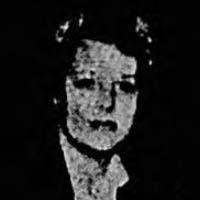
Lesley Lunn, 1942. Detail of photo published in the Capital Journal 17 Dec 1942 pg 11
Helen Lesley Swank Lunn Nastiuk (1916-1996)
Positions Held: Fire Lighter
Helen Lesley Swank was born in Prineville, Oregon to Morris/Maurice/Morico Swank and Addie M. Bailey on July 13, 1916. She grew up in Glendale, Douglas County, Oregon, but attended high school in Medford. Sometime before 1940, she married Earl Lunn and had two daughters. By 1940, she had moved back in with her parents, as her husband Earl had been diagnosed with Tuberculosis and was confined to the State T.B. Hospital in Salem. Lesley moved to Salem, likely to be closer to the hospital. Earl appears to be in and out of the hospital for nearly six years and would eventually succumb to the disease in 1945.
In 1946, Lesley married Michael R. Nastiuk. She died in Sacramento, C.A. on 24 April 1996 and is buried in the Canyonville Cemetery.
Sources and Transcriptions:
Birth Certificate, Crook County (Ancestry.com)
Helen Swank, born Prineville, Oregon
Female
Father: Morris Swank, HowardOre. Born Brownsville Mechanic
Addie M. Bailey, Howard, Oregon, born Canyonville, Oregon, Housewife
July 13, 1916
1920 US Federal Census (Ancestry.com)
Glendale, Douglas, Oregon
Swank, Maurice, Head, 51, Blacksmith, Lumber co.
Addie M., Wife, 41
John, J. Son, 18, Laborer, Saw mills
Paul L, Son, 13
Margerite B., 10
Elizabeth D., Daughter, 7 9/12
Helen L, Daughter, 3 5/12
1930 US Federal Census (Ancestry.com)
Glendale, Douglas, Oregon
Swak, Maurice, head, 60, Oregon
Addie, wife, 51, Oregon
Marguerite, Daughter, 20, Oregon
Helen, Daughter, 13, Oreogn
“To Enter School Here.” Medford Mail Tribune 10 Sep 1935 pg 7 (Newspapers.com)
Mrs. M. Swank and daughter, Miss Helen Swank of Glendale, Ore., arrive this morning by train. Miss Swank will enroll this winter at Medford high school.
1940 US Federal Census (Ancestry.com)
Glendale, Douglas, Oregon
Swank, Maurice, Head, 70, Oregon, Blacksmith, Lumber Mill
Swank,Addie M., Wife, 61, Oregon
Beall, Donna, Daughter, 28, Oregon – Same house 1935, Sorter, Fruit Packing
Beall, E.Vern, Grandson, 10, Oregon – Same House 1935
Beall, Donna, Grand Daughter, 8, Oregon
Beall,Albert, Grandson, 5, California
Lunn, Helen, Daugher, 23, Oregon, Same ouse
Lunn, Adeline, 2, granddaughter
Lunn, Sandra, Grand Daughter, 2 /12
“Glendale’ Roseburg News Review 11 Feb 1941 pg 4 (Newspapers.com)
Mrs. Earl Lunn and Mrs. Lawrence Tuttle returned Friday from a visit in Salem with Mr. Lunn, who is confined to a hospital there.
Polk’s City Directory, 1942 (WHC Collections)
Lunn, Earl A. (H. Lesley) h. 1346 Lee Street
“Lunn Children go to Glendale.” Oregon Statesman 02 Aug 1944 pg 3 (Newspapers.com)
Lincoln – Adeline and Sandra Lunn, children of Mr. and Mrs. Earl Lunn, who have been staying at the L.I. Mickey home for the past two weeks left Sunday with their maternal grandmother, for Glendale, where they will make their home for an indefinite time. Their mother, Mrs. Lunn, is working and the father is ill.
Oregon State Death Certificate. (Ancestry.com)
Date of Death 15 Feb 1945
Earl Elmer Lunn. Place of death Oregon State Tuberculosis Hospital. Stay 1553 days (6 years)
Wife Helen Lesley Lunn
Cause of Death TB.
1945 City Directory
Lunn, Helen Mrs. Fireliter SP Co. r 1440 Waller
Clark County Marriage Record (Ancestry.com)
28 Sept 1946
Marriage Between Michael R. Nastiuk (divorced) and Helen L. Lunn (widow)
“Mrs. A.M. Swank, Ex Canyonville Resident, dies.” Roseburg News Review 04 Mar 1949 pg 2 (newspapers.com) – Lists Lesley and Donna
US Social Security Index (Ancestry.com)
Helen Lesley Swank Nastiuk Lunn
Female, White
Born 13 July 1916 Prineville, Oregon
Death Date: 24 Arp 1996. SNN 572091520
California Death Index (Ancestry.com)
Helen Lesley Nastiuk
Female, born 13 Jul 1917 Oregon
Death: 24 April 1996 Sacramento
Father’s Surname: swank
Mother’s Maiden Name: Bailey
Findagrave – Canyonville Cemetery https://www.findagrave.com/memorial/116857165/helen-lesley-nastiuk
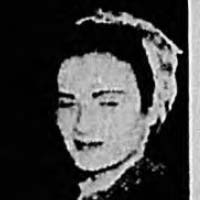
Edna Zander, 1942. Photo published Capital Journal 17 Dec 1942 pg 11.
Edna Elsie Hirschkorn Bassell Zander Moore Loveless (1922-1989)
Edna Elsie Hisrchkorn was born 2 Feb 1922 in Belgrade, Montana to Emmanuel Hirschkorn and Mary Eberhardt. She married Charles T. Zander Jr. at Yakima when she was 18 and he 19 years of age. By 1942, the couple had moved to Salem where Charles was working as a driver. Her tenure with the railroad seemed to be short lived. By 1945, she was working as a waitress at the Comet Café in Salem. In 1946, she filed for divorce.
Edna died in Santa Clara, California on 14 Feb 1989.
*Note that Charles T. Zander was the brother of Donald Zander married to Leota Real Zander. See next bullet point for full connection.
Sources and Transcriptions:
Birth Record (Ancestry.com)
Edna Elise Hirschkorn, Female, Born 2 Feb 1923. 13 N West, Belgrade, Gallatin, Montana
Father: Emmanuel Hirschkorn
Mother: Mary Eberhardt
1930 US Federal Census (Ancestry.com)
Belgrade, Gallatin, Montana
George Bassell, 43 Head
Mary Bassell, 34 wife
Hilda Hirshkorn, 12 Step daughter
Herbert Hirshkorn, 10 Son
John Hirshkorn, 9 Son
Edith Hirshkorn, 8 Daughter
Edna E. Bassel, 7 Daughter
George Bassel, 5 Son
Marriage Record Yakima, Washington, USA (Ancestry.com)
Application for Marriage License 5 March 1941
Groom: Charles Zander, Jr. 19, White, born Missoula, MT Residence Yakima
Bride: Edna Hirschkorn, 18, White born Belgrade Montana, Residence Yakima
1942 Salem City Directory (WHC Collections)
Zander, Charles h 378 Evergreen Av
Zander, Chester Z A (Viola J.) bkpr h 2030 N Commercial
Zander, Donald H. (Leota) driver h 1345 Waller
Zander Hubert R (Dee) plstr h 100 Duncan Ave
“First Aid Needed.” Oregon Statesman 19 Jan 1943 pg 5 (Newspapers.com)
Mrs. Edna Zander, 576 Locust Street called city first aid men Monday afternoon when she cut her left hand with an axe. They applied a temporary dressing and sent her to a doctor.
“Circuit Court” Oregon Statesman 14 Feb 1946 pg 5 (Newspapers.com)
Edna Zander vs Charles T. Zander: Suit for divorce charging cruel and inhumane treatment asks for $50 per month support money and asks that maiden name of Edna Hirschkorn be restored plaintiff. Married March 5, 1941
“Circuit Court.” Oregon Statesman 13 Sept 1946 pg 4 (Newspapers.com)
…Edna Zander vs Charles T. Zander, Jr. Decree of divorce restoring maiden name, Edna Hirschkorn to plaintiff.
Santa Clara City Directory 1977 (Ancestry.com)
Loveless, Edna E. (Widow Reed) retd h 44 N Jackson Ave. Aprt 17 i
California Death Index (Ancestry.com)
Death 14 Feb 1989, Santa Clara
Social Security Applications and Claims Index (Ancestry.com)
Edna Elsie Bassell
Edna Elsie Zander
Edna Moore
Edna Loveless
Edna Elsie Hirschkorn
Female, White, born 2 Feb 1922 Belgrade (Livingston) Montana
Death Feb 1989
Father: Emmanuel Hirschkron
Mother: Mary Eberhardt
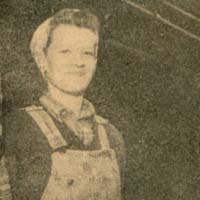
Leota Zander, 1947. Your Town Press Article. Detail. WHC Collections 81.2.63.1
Leota Louise Real Zander Woodruff (1920-1993)
Positions Held: Fire Lighter
Leota “Lee” Lousie Real was born 30 June 1920 in Sioux City, Iowa to Earnest Real and Ruby Mayfield. At age 16, she married Donald H. Zander in Vancouver, Washington, although their marriage certificate states they were both residing in Marion County, Oregon at the time. It was common for folks in Oregon to get married in Vancouver as it was a quick trip and the license requirements for Washington marriages were less stringent. Donald worked as a driver and the couple were living at 1345 Waller Street in Salem in 1942. By 1944, when Donald enlisted, he remarked he was separated with dependents on his form. The pair finalized their that same year.
Leota worked as a firelighter in Salem. Perhaps it was this position that introduced her to H.A. Woodruff, a fireman with the Southern Pacific based in Ashland, Oregon. The couple was married in Salem on March 13, 1947. By 1950 the family had moved to Klamath Falls.
Leota died in 1993 at age 72. Her obituary stated: She was a homemaker and enjoyed writing poetry and camping. No mention of her time working on the railroad.
Sources and Transcriptions:
Iowa Birth Index (Ancestry)
30 Jun 1920 Sioux City, Woodbury, Iowa
Earnest Real / Ruby Mayfield
1930 US Federal census (Ancestry.com)
Meadow Grove, Madison, Nebraska
Harl Real, 65, Head, Indiana, farmer
Mary R. Real, 56, Wife, Iowa
Edna E. Real, 19, daughter, Nebraska
Alice P. Real, 15, daughter, Nebraska
Lucile Real, 13 Granddaughter, Nebraska
Leota Real, 10, Granddaughter, Nebraska
Certificate of Marriage (Vancouver, Clark County) Ancestry.com
6 Nov 1936 did join in lawful matrimony Don H. Zander, Marion County, Oregon
Leota Real Marion County, Oregon. Witnesses Mr. and Mrs. Morris Osborne.
1942 Salem City Directory (WHC Collections)
Zander, Charles h 378 Evergreen Av
Zander, Chester Z A (Viola J.) bkpr h 2030 N Commercial
Zander, Donald H. (Leota) driver h 1345 Waller
Zander Hubert R (Dee) plstr h 100 Duncan Ave
1944 – Donald Zander Enlistment (Ancestry.com)
White, Separated with dependants, Private. Bron 1919 in Montana. Residence: Marion, Oregon, Education, Grammar School. Civil Occupation Semiskileld chauffeurs and drivers, bus, taxi, truck and tractor. Enlistment date 19 Jan 1944 in Portland, Oregon. Service Number 39343914.
Public Record Oregon Statesman 27 Oct 1944 pg 5 (Newspapers.com)
Circuit court…
Leota Louise Zander vs. Donald Howard Xander; answer suggests that since plaintiff is employed and not in position to care for minor children they be left in custody of their material grandmother until mother is able to maintain a home for them, denies portion fo divorce complaint, agrees that money asked for support is reasonable but asks that any decree be subject to modification in regard to the alimony with the defendant’s ability to pay as basis for decision and that all alimony bet terminated should plaintiff remarry, asks dismissal of case.
Divorce Record (Ancestry.com)
Docket No. 31705
Husband: Donald Howard Zander
WIFE: Place of Divorce – Marion, Court: Circuit. Place of Marriage: Washington, Vancouver. Date of Marriage 6 Nov 1935. Date of Separation: March 942. Date of filing petition. October 17, 1944. Date of decree or judgement Nov 6, 1944. Plaintiff, Wife. Was case contested, No. Cause or ground of divorce: Cruel and Inhumane treatment. Divorce granted to wife. Alimony granted, yest. Total number of Children affected by divorce 2. Total number of children by marriage 2. Maiden name: Leota Louise. Residence at the time of divorce, Oregon.
Your Town. 31 Jan 1947
Leota Zander has been working four years and is a fire lighter…both girls certainly seemed to be having a good time at their jobs.
“Fireman, Fire Lighter Get Marriage License.” Oregon Statesman. 13 March 1947 pg 2 (Newspapers.com)
Sages hold that having like interests insures a successful marriage for a couple. If true, then H.A. Woodruff, 35 of Ashland, and Leota Zander, 26, Salem, should do all right, according to their marriage license application field with the Marion county clerk’s office Wednesday. Woodruff lists his occupation as a locomotive fireman and Miss Zander is a fire lighter. Both work for the Southern Pacific railroad.
Marriage Index (Ancestry.com)
13 Mar 1947 Marion County. Leota Zander and H. Woodruf
Return of Marriage (Ancestry.com) Marion County #5690
Date of Marriage 13 March 1947 – Salem, Marion, Oregon
H.A. Woodruff – Ashland, Jackson, Oregon, White, Age 35. DOB 18 Oct 1911. Divorced, 2nd marriage. Born Oregon. Occupation: Locomotive Fireman.
FATHER: born Nebraska, Logger. MOTHER born USA Housewife
—
Leota Zander
Residence: Salem, Marion, Oregon. White, age 26. Born 30 June 1920. Divorced. Second Mariage. Birthplace Iowa. Occupation: Fire Lighter.
FATHER: Born Nebraska, Farmer. MOTHER Iowa, Deceased.
1950 US Federal Census (Ancestry.com)
Klamath Falls, Klamath, Oregon
Woodruff, Heral A., Head, 38, Oregon, freight fireman, Railroad
Leota L., wife, 29, Iowa
Betty I., daughter, 13, Oregon
Donna L, daughter, 8, Oregon
Michael A., son, 2, Oregon
“Leota Louise ‘Lee’ Woodruff” Statesman Journal. 06 Apr 1993 pg 21 (Newspapers.com)
June 30, 1920 – April 3, 1993
Leota Louise “Lee” Woodruff, 72, of Salem died Saturday.
She was born in Sioux City, Iowa, and moved to Salem in 1938 from Meadow Grove, Neb.
She married Heral A. Woodruff on March 13, 1947; he died Oct. 31, 1978.
She was a homemaker and enjoyed writing poetry and camping.
Survivors include daughters, Betty Hamilton of Salem and Donna Warren of Reno, Nev.; Son Michael of Woodland, Wash.; brother, Ernest “bus Real of Salem; sister, Luciclle Nelson of Salem; six grandchildren; and nine great-grandchildren.
Services will begin at 10 am Wednesday in Howell-Edwards-Doerksen morturary. Internent will be at Forest Vale Cemetery in Oakridge. S.J. 4/6/93
Social Security Index (Ancestry.com)
Leota Jreal Zander
Leota Louise Woodruff
Leota Woodruff
Leota Jreal Real
Female
White
Birth date: 30 June 1920 Sioux City, Iowa
Death date 3 April 1993
Father: Ernest Real
Mother: Ruby Mayfield
SSN: 541180289
Oct 1938 – Leota Jreal Zander
Feb 1951 Leota Louise Woodruff
13 Apr 1993 LEota Woodruff
Forestvale Memorial Park (Find-a-grave)
CONNECTION BETWEEN CHARLES AND DONALD ZANDER
They were brothers:
1930 US FEDERAL CENSUS (Ancestry.com)
Salem, Marion, Oregon –2355 Laurel Avenue
Charles I Zander, Head, 38, Montana (Germany/unknown), laborer Paper Mill
Della, 32 Montana (Canada/Oregon)
Leona, daughter, 12 (Montana/Montana)
Donald, Son, 10
Charles, son, 8
Albert, Son, 3 4/12
Marie L, 11/12
US INDIAN CENSUS ROLL 1937 (Ancestry.com)
Zander, Della A. Courville brn. 1/24/1898, 39 3/8 Living Salem, Marion, Oregon Flathead reservation affiliation. No tribal affiliation noted in census, just reservation.
Clara Leona, brn 11/20/1917, 20, 3/16
Donald Howard, brn 8/12/1919, 3/16
Charles Jr., born 2/18/1922, 15, 3/16
“Donald H. Zander. Statesman Journal 17 Nov. 1986 (Newspapers.com)
Donald H. Zander, 67, of Salem died Saturday.
He was born in Missoula, Mont., and was a resident of Salem for the past 60 years. He was employed as a truck driver for the North Pacific Lumber Co. of Portland for 23 years, retiring in 1982. He was a U.S. Army veteran of World War II.
Survivors include his wife, Irene P.,; daughters Betty Hamilton, Salem, Donna Warren, Carson City, Nev.; stepdaughter, Beverly Springer, Bend; brothers Charles, Polson, Mont., Albert, Pendlton, Richard, Salem; sisters Leona Osbourne, Longview, Wash., and Marie Ramey, Salem…
Death Certificate: Charles Temby Zander, Jr. 1996 (Montana –Ancestry.com)
American Indian (race). Mother Julia Adeline Courville father Charles Temby Zander, Sr.
Citations
[1] Women Working on the Railroad – exhibit Union Pacific Museum: https://www.uprrmuseum.org/uprrm/exhibits/traveling/women-railroad/index.htm
[2] Advert. Capital Journal 22 Jun 1943 pg. 7 (Newspapers.com). . And because over twelve thousand SP “regulars” have gone to war, we need to enlist more patriotic men to keep the war trains rolling. WE need patriotic women, too. By 1943, the number of men that had gone into the service topped 13,000. See S.P. Makes Improvements Here. Capital Journal 31 Oct 1943 pg 4 (Newspapers.com)
[3] S.P. Makes Improvements Here. Capital Journal 31 Oct 1943 pg 4 (Newspapers.com)
[4] Advert. Capital Journal 22 Jun 1943 pg 7 (Newspapers.com). See also “Women Work on Rail Gangs.” Capital Journal 01 May 1943 (Newspapers.com)
[5] S.P. Makes Improvements Here. Capital Journal 31 Oct 1943 pg 4 (Newspapers.com)
[6] “Girls Make good as Railroad workers.” Capital Journal 17 Dec 1942 pg 11 (Historic Oregon Newspapers
[7] “Oil Blaze Put out in Locomotive.” Oregon Statesman 02 July 1942 pg 2 (Newspapers.com); See also the 1950 Sanborn Fire Insurance Maps superimposed over GoogleMap – research conducted by author.
[8] Marshall, Tom. “Silence Rules at SP Roundhouse.” Oregon Statesman 21 Nov 1958 pg 1. (Newspapers.com)
–“The Salem roundhouse was established in in 1926. It was actually not a “roundhouse” but instead utilized “Y” tracks to turn trains around.”
–“after it was reported Southern Pacific Would close its Salem roundhouse in an economy move.”
–” An oily smell filled the area. Four silent Diesel locomotives hooked-up in tandem, stood still outside the converted box car that is the roundhouse.”
[9] See 1950 Sanborn Maps which show restrooms, shacks, oil house, sand house, etc. in the vicinity.
[10] Railway Roundhouse definition: https://en.wikipedia.org/wiki/Railway_roundhouse. Note that many sources indicate that instead of a turntable, the Salem Roundhouse was placed at the Geer “Wye” which allowed for locomotives to be turned around without the aide of turn table – just a three point turn.
[11] Marshall, Tom. “Silence Rules at SP Roundhouse.” Oregon Statesman 21 Nov 1958 pg 1. (Newspapers.com)
[12] Marshall, Tom. “Silence Rules at SP Roundhouse.” Oregon Statesman 21 Nov 1958 pg 1. (Newspapers.com) states “14 men affected by the action.”; “Workers spend Final days at SP Roundhouse Here.” Capital Journal 1 Dec 1958 pg 1. (Newspapers.com) describes 12 workers; “C.P. Davis, SP Roundhouse Chief, Retires.” Oregon Statesman 17 Aug 1952 pg 5 (Newspapers.com) states that the “crew at the roundhouse now totals 30 men.”; “Accident-Free Record Set by SP Workers” Oregon Statesman 30 Mar 1956 pg 2 (Newspapers.com) records “the roundhouse near 12th and Oak Streets now employs 11 men, but it had a larger crew during World War II.”
[13] “Fire Destroys Pullman Car Bunk-House” Oregon Statesman 31 Dec 1959 pg 2 (Newspapers.com); See also Sanborn Fire Insurance MAP 1950.
[14] “Girls Make good as Railroad workers.” Capital Journal 17 Dec 1942 pg 11 (Historic Oregon Newspapers)
[15] Donna Elizabeth Swank Beall Tuttle Wending Luke. Birth Certificate (Canyonville, Douglas, Oregon) (Ancestry.com) Donna Elizabeth Swank, Female, fifth child. Born 17 Feb 1912 to Monrico Swank (43) and Addie Bailey (32). 1920 US Federal Census (Ancestry.com) Glendale, Douglas, Oregon shows bothe Elizabeth D. (Donna Elizabeth) and Helen L. (Helen Lesley) enumerated together as siblings. They are enumerated again in the 1940 US Federal Census (Ancestry.com) Glendale, Douglas, Oregon with their parents, except listed this time under their married names.
[16] Helen Lesley Swank Lunn Nastiak. Birth Certificate, Crook County (Ancestry.com) Helen Swank, born Prineville, Oregon
Female Father: Morris Swank, Howard, Ore. Born Brownsville Mechanic; Addie M. Bailey, Howard, Oregon, born Canyonville, Oregon, Housewife July 13, 1916. See Note 15. Also
[17] Leota Zander was born Leota Real 30 Jun 1920 in Sioux City, Woodbury, Iowa. See Iowa Birth Index (Ancestry), 1930 US Federal census (Ancestry.com) Meadow Grove, Madison, Nebraska (Grandparents J. Harl Real and Mary R. Real); Certificate of Marriage (Vancouver, Clark, Washington) ) Ancestry.com
6 Nov 1936 did join in lawful matrimony Don H. Zander, Marion County, Oregon Leota Real Marion County, Oregon. Establishes Leota Real was the wife of Don H. Zander. See 1930 US Federal Census (Ancestry.com) Salem, Marion, Oregon –2355 Laurel Avenue shows Charles I Zander, Head, 38, montana (Germany/unknown), laborer Paper Mill, with wife named Della and son named Donald and son named Charles. See also US INDIAN CENSUS ROLL 1937 (Ancestry.com) Zander, Della A. Courville and obituary for “Donald H. Zander. Statesman Journal 17 Nov. 1986 (Newspapers.com), all of which demonstrate that Charles Temby Zander Jr. and Donald Howard Zander were brothers, making their wives sisters-in-law.
[18] Edna Elise Hisrchkorn. Birth Record (Ancestry.com); Marriage Record Yakima, Washington, USA (Ancestry.com) Application for Marriage License 5 March 1941 Groom: Charles Zander, Jr. 19, White, born Missoula, MT Residence Yakima Bride: Edna Hirschkorn, 18, White born Belgrade Montana, Residence Yakima. See foot note 17 establishing relationship between Donald H. Zander and Charles Temby Zander, Jr. as brohters.
[19] Your Town. 31 Jan 1947 Margie Konrad (left) has been working for S.P. for three years as “supply man.”
[20] “Girls Make good as Railroad workers.” Capital Journal 17 Dec 1942 pg 11 (Historic Oregon Newspapers)
[21] “Girls Make good as Railroad workers.” Capital Journal 17 Dec 1942 pg 11 (Historic Oregon Newspapers)
[22] 1947 Salem City Direction lists Margie Konrad as Stationary Firewoman SP. Railroad Company (WHC Collections); The 1945 Salem City Directory lists Marige Konrad as Supply woman, Helen Lunn as Fire lighter, Leota Zander and Donna Beall as Stationary Fireman for the Southern Pacific Company; “Fireman, Fire Lighter Get Marriage License.” Oregon Statesman. 13 March 1947 pg 2 (Newspapers.com)
Sages hold that having like interests insures a successful marriage for a couple. If true, then H.A. Woodruff, 35 of Ashland, and Leota Zander, 26, Salem;
[23] During her employment Leota Louise Zander was separated from her husband (1944 – Donald Zander Enlistment (Ancestry.com) White, Separated with dependents, Private. Born 1919 in Montana. Residence: Marion, Oregon, Education, Grammar School. Civil Occupation Semi skilled chauffeurs and drivers, bus, taxi, truck and tractor. Enlistment date 19 Jan 1944 in Portland, Oregon. Service Number 39343914) and went through a divorce (Oregon Statesman 27 Oct 1944 pg 5 (Newspapers.com) Circuit court… Leota Louise Zander vs. Donald Howard Xander; answer suggests that since plaintiff is employed and not in position to care for minor children they be left in custody of their material grandmother until mother is able to maintain a home for them). Because of her employment, one condition of the divorce was that the children stay with their grandmother until Leota could create a home for them. Lesley Lunn’s husband was confined to the State Tuberculosis Hospital (where he would eventually succumb to the disease during her employment). See “Lunn Children go to Glendale.” Oregon Statesman 02 Aug 1944 pg 3 (Newspapers.com) Lincoln – Adeline and Sandra Lunn, children of Mr. and Mrs. Earl Lunn, who have been staying at the L.I. Mickey home for the past two weeks left Sunday with their maternal grandmother, for Glendale, where they will make their home for an indefinite time. Their mother, Mrs. Lunn, is working and the father is ill; Oregon State Death Certificate. (Ancestry.com) Earl Elmer Lunn. Place of death Oregon State Tuberculosis Hospital. Stay 1553 days (6 years) Wife Helen Lesley Lunn. Cause of Death TB.
[24] “Phoebe Narrow Gauge All Steamed up, Nowhere to go.” Capital Journal 22 Feb 1944 pg 10 (Newspapers.com)
[25] “Phoebe Narrow Gauge All Steamed up, Nowhere to go.” Capital Journal 22 Feb 1944 pg 10 (Newspapers.com), describes the girls tending to Little Phoebe. “Strike Comes to Salem.” Capital Journal 24 May 1946 pg 1 (Newspapers.com) names Donna Beall as the stationary fireman for Little Phoebe.
[26] “Fireman, Fire Lighter Get Marriage License.” Oregon Statesman. 13 March 1947 pg 2 (Newspapers.com)
[27] Diesel Electric Locomotives http://www.railswest.com/dieselelectloco.html states:” On the Southern Pacific, they began using diesel electric locomotives in main line operation in 1947. The last Southern Pacific steam locomotive was retired in 1957.”
[28] See “Strike Comes to Salem.” Capital Journal 24 May 1946 pg. 1 (Newspapers.com). “Donna Beall…wonders what she’ll do next. She’s a stationary fireman, not on strike herself, but out of a job because others are..”
[29] “Goodbye Phoebe Narrow Gauge” Capital Journal 31 May 1952 pg. 13 (Newspapers.com)
[30] https://www.zippia.com/railroad-worker-jobs/demographics/ 2023 – 5.7% women
[31] “Donna E. Luke.” Statesman Journal 22 Jul 1999 pg. 21 (Newspapers.com)



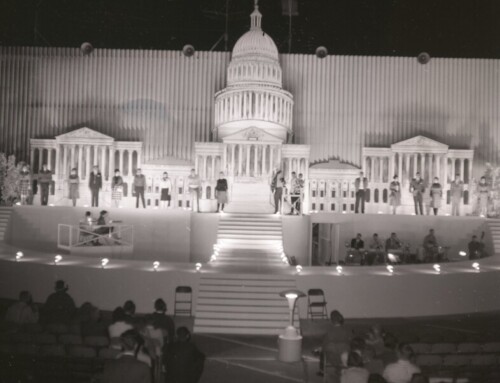
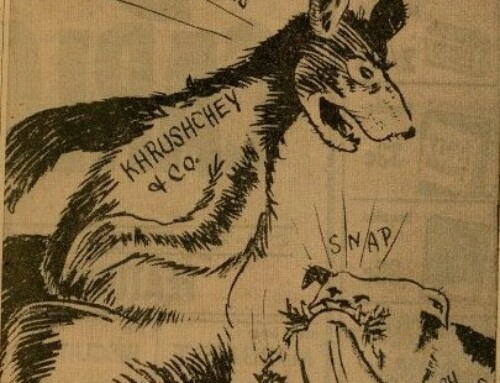
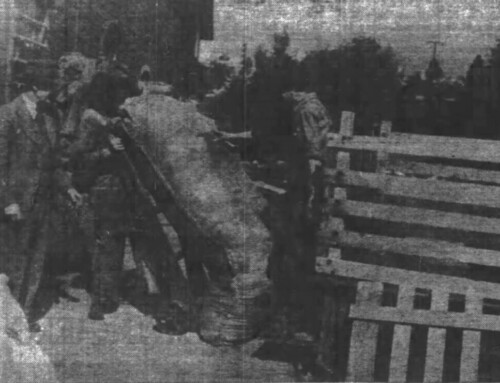
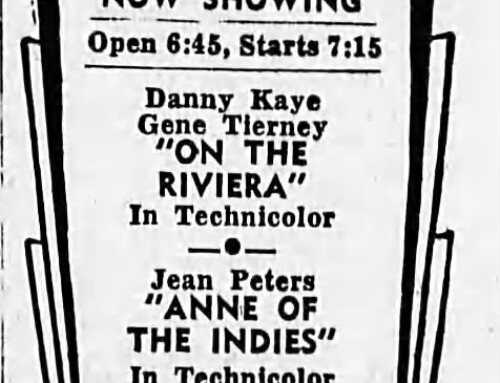
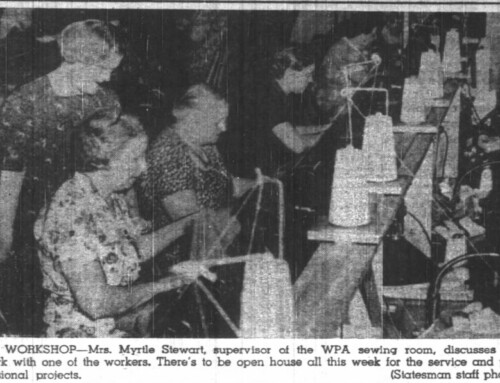
Leave A Comment